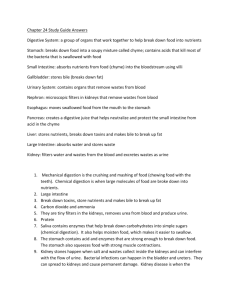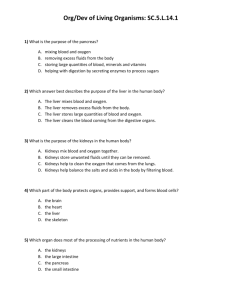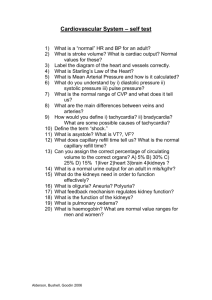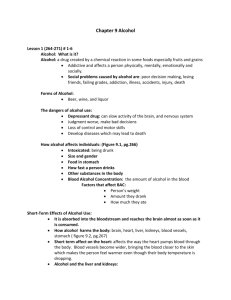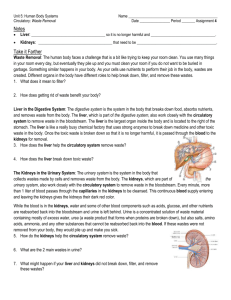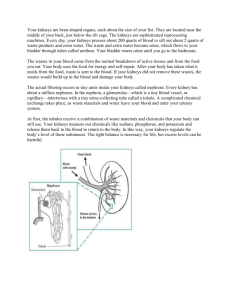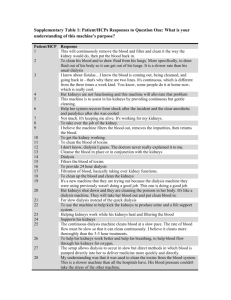Elimination of Waste
advertisement
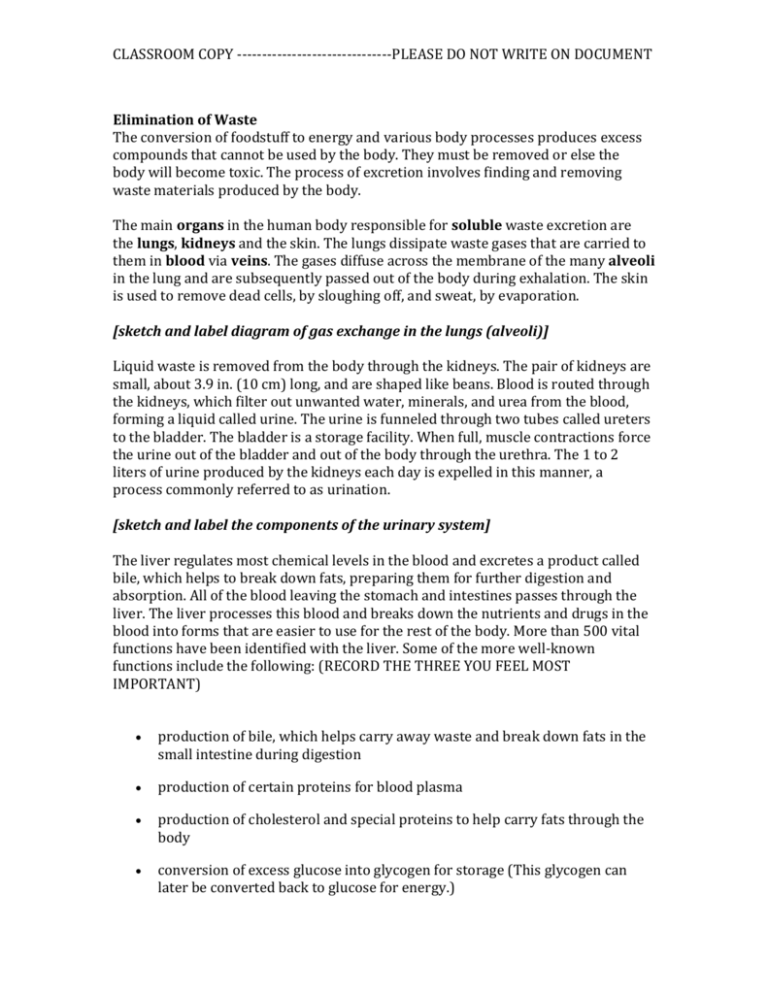
CLASSROOM COPY -------------------------------PLEASE DO NOT WRITE ON DOCUMENT Elimination of Waste The conversion of foodstuff to energy and various body processes produces excess compounds that cannot be used by the body. They must be removed or else the body will become toxic. The process of excretion involves finding and removing waste materials produced by the body. The main organs in the human body responsible for soluble waste excretion are the lungs, kidneys and the skin. The lungs dissipate waste gases that are carried to them in blood via veins. The gases diffuse across the membrane of the many alveoli in the lung and are subsequently passed out of the body during exhalation. The skin is used to remove dead cells, by sloughing off, and sweat, by evaporation. [sketch and label diagram of gas exchange in the lungs (alveoli)] Liquid waste is removed from the body through the kidneys. The pair of kidneys are small, about 3.9 in. (10 cm) long, and are shaped like beans. Blood is routed through the kidneys, which filter out unwanted water, minerals, and urea from the blood, forming a liquid called urine. The urine is funneled through two tubes called ureters to the bladder. The bladder is a storage facility. When full, muscle contractions force the urine out of the bladder and out of the body through the urethra. The 1 to 2 liters of urine produced by the kidneys each day is expelled in this manner, a process commonly referred to as urination. [sketch and label the components of the urinary system] The liver regulates most chemical levels in the blood and excretes a product called bile, which helps to break down fats, preparing them for further digestion and absorption. All of the blood leaving the stomach and intestines passes through the liver. The liver processes this blood and breaks down the nutrients and drugs in the blood into forms that are easier to use for the rest of the body. More than 500 vital functions have been identified with the liver. Some of the more well-known functions include the following: (RECORD THE THREE YOU FEEL MOST IMPORTANT) production of bile, which helps carry away waste and break down fats in the small intestine during digestion production of certain proteins for blood plasma production of cholesterol and special proteins to help carry fats through the body conversion of excess glucose into glycogen for storage (This glycogen can later be converted back to glucose for energy.) CLASSROOM COPY -------------------------------PLEASE DO NOT WRITE ON DOCUMENT regulation of blood levels of amino acids, which form the building blocks of proteins processing of hemoglobin for use of its iron content (The liver stores iron.) conversion of poisonous ammonia to urea (Urea is one of the end products of protein metabolism that is excreted in the urine.) clearing the blood of drugs and other poisonous substances regulating blood clotting resisting infections by producing immune factors and removing bacteria from the bloodstream When the liver has broken down harmful substances, they are excreted into the bile or blood. Bile by-products enter the intestine and ultimately leave the body in the feces. Blood by-products are filtered out by the kidneys and leave the body in the form of urine. Feces (also called excreta or stool) is a solid waste product of digestion. The solid forms as waste material is moved through the large intestine by muscular contractions called peristalsis. In humans, approximately 8.8 oz. (250 g) of feces are produced each day. Typically the solid waste is comprised of digestive secretions, enzymes, fats, cell debris, electrolytes, water, and some protein. Also, up to 20% of the weight of the solid can be bacteria. If the elimination of liquid or solid wastes are disrupted, the consequences for the health of the organism can be serious. For example, if kidneys are diseased and not functioning properly, the buildup of waste can necessitate a treatment known as dialysis. In dialysis, the patient's blood is pumped out of the body and through a dialysis machine. The machine acts as a filter instead of the kidneys. The cleansed blood is then pumped back into the patient. If dialysis fails to correct the problem, a kidney transplant may be necessary. Often the donor of a kidney is a sibling or some other close relation, whose genetic make-up is similar to the patient's.
